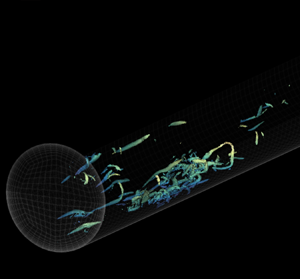Article contents
Transient dynamics of accelerating turbulent pipe flow
Published online by Cambridge University Press: 29 April 2021
Abstract

The transient dynamics of accelerating turbulent pipe flow has been examined using direct numerical simulation (DNS) data sets with a high spatiotemporal resolution, starting from low and moderate Reynolds numbers. The time-dependent evolution of the mean flow dynamics reveals that internal flows, during and after a rapid increase in the flow rate, experience four unambiguous transient stages: inertial, pre-transition, transition and core relaxation before they reach their final steady-state. The first stage is characterised by a rapid and substantial increment in the viscous forces within the viscous sublayer, together with the frozen behaviour of the existing turbulent eddies. The pre-transitional stage reveals a weak response of the turbulent inertia within the near-wall region, together with a rapid reduction in the viscous forces. At the third stage, termed transition, balanced growth in the magnitude of both the turbulent and the viscous forces within  $y^{+0} \lesssim 50$ is observed. The final stage, referred to as core relaxation, shows a quasi-steady behaviour at
$y^{+0} \lesssim 50$ is observed. The final stage, referred to as core relaxation, shows a quasi-steady behaviour at  $y^{+0} < 50$ and reveals the slow propagation of turbulence from the near-wall region into the wake region. A decomposition of the skin friction coefficient (
$y^{+0} < 50$ and reveals the slow propagation of turbulence from the near-wall region into the wake region. A decomposition of the skin friction coefficient ( $C_f$), using an FIK identity suitable for unsteady pipe flow, shows a progressive increment in the turbulent contribution during the core-relaxation period. Simultaneously, the unsteady contribution decreases proportionally, maintaining a plateau in
$C_f$), using an FIK identity suitable for unsteady pipe flow, shows a progressive increment in the turbulent contribution during the core-relaxation period. Simultaneously, the unsteady contribution decreases proportionally, maintaining a plateau in  $C_f$. The principal mechanism responsible for this slow regeneration in the wake is a temporal turbulence stratification at the inner region of the flow, together with a quiescent core, which maintains geometric coherence across extensive periods.
$C_f$. The principal mechanism responsible for this slow regeneration in the wake is a temporal turbulence stratification at the inner region of the flow, together with a quiescent core, which maintains geometric coherence across extensive periods.
- Type
- JFM Papers
- Information
- Copyright
- © The Author(s), 2021. Published by Cambridge University Press
References
REFERENCES
- 17
- Cited by



